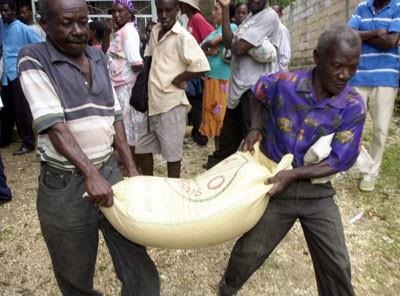Haiti: six months on, agriculture needs more support
15 July 2010, Rome/Port-au-Prince - While timely food assistance and agricultural inputs helped avert a post-earthquake food crisis in Haiti, insufficient funding for agriculture continues to hamstring efforts to improve food security, local food production and provide income opportunities in rural areas six months after the devastating quake.
Rural areas neglected
"Most of the response has been focussing on the urban aspect of the crisis, but the international community must not neglect rural areas if they want to overcome the massive effects of the earthquake in the country," said FAO Senior Emergency and Rehabilitation Coordinator for Haiti Etienne Peterschmitt.
"Greater investment in agriculture and the creation of jobs in rural areas are needed urgently to stem the flow of displaced people back into Port-au-Prince and to support food security throughout the country."
FAO and the Ministry of Agriculture distributed agricultural inputs to 72 000 farming families in earthquake-hit and rural areas in time for the critical spring planting season, which accounts for 60 percent of Haiti's agricultural production. This assistance has enabled over 360 000 people to produce and consume their own locally produced food, selling the surplus to cover health and education expenses.
FAO and the Ministry of Agriculture are leading the agriculture cluster, a UN coordination mechanism which spearheads the reconstruction efforts in agriculture in Haiti. The agriculture cluster, which comprises over 170 non-governmental and international organizations, plans to reach an additional 80 000 rural families in the summer planting season with tools, fertilizers, water pumps and high quality seeds, which will increase local food production.
In addition 10 000 households will receive assistance in vegetable gardening as part of FAO's urban agriculture intervention in areas around Port-au-Prince, Ganthier and Cabaret.
"Immediately after the disaster hit in January we focussed on areas directly affected by the earthquake," said Cristina Amaral, Chief of FAO Emergency Operations Service. "Now we are focussing on assisting host families whose coping mechanisms were severely strained by the influx of displaced persons into their communities and to prepare for the hurricane season."
The overall scope of the agriculture cluster reconstruction work in Haiti is to support local food production and marketing in rural areas, urban agriculture, reforestation and disaster risk reduction activities to create jobs in rural areas.
Stormy weather
With experts anticipating a busier-than-usual hurricane season this year, FAO and the agriculture cluster are also working with the Ministry of Agriculture of Haiti and the civil protection agency to ensure that farmers are prepared.
They will set up seed and tool stocks in strategic locations in hurricane-prone areas that can be quickly moved if needed. With the assistance of Japan and Spain, 250 tonnes of beans and maize seeds, over 50 000 tools as well as 5 400 kgs of vegetable seeds and 650 tonnes of fertilizer will be stored in these stocks.
In addition, FAO is actively supporting the "Coordination nationale pour la sécurité alimentaire", the Government of Haiti's food security observatory, to strengthen the national agriculture and food security information network, and share relevant information with the main partners involved in rebuilding agriculture in the country.
Crop assessment mission
A joint FAO/WFP Crop and Food Supply Assessment Mission team is currently consolidating its findings from field visits to agricultural regions throughout the country. The mission report, which will examine 2010 crop prospects and the food security situation in earthquake-hit areas and communities hosting the displaced, will be published in early August.
